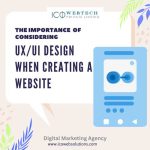Visual hierarchy is a key aspect of e-commerce website design. It refers to the arrangement of visual elements on a page in order of importance. By using visual hierarchy, eCommerce businesses can guide customers’ attention to the most important elements on their pages, such as product images, call-to-action buttons, or customer testimonials. In this article, we’ll explore the importance of visual hierarchy in eCommerce website design and provide some tips for creating an effective visual hierarchy.
What is Visual Hierarchy?
Visual hierarchy is the arrangement of visual elements on a page in order of importance.
It helps guide customers’ attention to the most important elements on the page, such as product images, call-to-action buttons, or customer testimonials. Visual hierarchy can be achieved through a variety of design techniques, including size, color, contrast, and placement.
Why is Visual Hierarchy Important in eCommerce Website Design?
Visual hierarchy is important in e-commerce website design for several reasons:
- It helps customers find what they’re looking for: E-commerce websites can be overwhelming, with hundreds or even thousands of products on offer. By using visual hierarchy, eCommerce businesses can guide customers’ attention to the products they’re most interested in, making it easier for them to find what they’re looking for.
- It improves the user experience: A well-designed e-commerce website with a clear visual hierarchy is easier to navigate and more enjoyable to use. Customers are more likely to stay on a website that is easy to use and find what they need.
- It increases conversions: By guiding customers’ attention to the most important elements on a page, such as call-to-action buttons or product images, eCommerce businesses can increase the likelihood that customers will take the desired action, such as making a purchase.
Tips for Creating Effective Visual Hierarchy in Ecommerce Website Design
Here are some tips for creating an effective visual hierarchy in e-commerce website design:
- Use size: One of the simplest ways to create a visual hierarchy is through size. Larger elements on a page are generally seen as more important than smaller ones. Use larger product images or headings to draw attention to the most important elements on the page.
- Use color: Color can also be used to create a visual hierarchy. Bright colors or high-contrast colors can be used to draw attention to important elements on the page, such as call-to-action buttons or special offers.
- Use contrast: Contrast refers to the difference between two elements on a page, such as light text on a dark background. By using contrast, eCommerce businesses can draw attention to the most important elements on the page.
- Use placement: The placement of visual elements on a page can also create a visual hierarchy. Place the most important elements, such as call-to-action buttons, in prominent positions on the page, such as above the fold or in the center of the page.
- Use whitespace: Whitespace, or the empty space around visual elements on a page, can also be used to create a visual hierarchy. By giving important elements more space, eCommerce businesses can draw attention to them and make them stand out.
What is Visual storytelling?
Visual Storytelling in e-commerce website design refers to the use of images, videos, and other visual elements to tell a story and create an emotional connection with customers.
It involves the use of visual elements to convey a brand’s message, values, and personality in a way that engages and inspires customers.
Visual storytelling is an important aspect of e-commerce website design because it can help businesses differentiate themselves from their competitors and build a loyal customer base. By using compelling visuals and telling a story that resonates with customers, eCommerce businesses can create a unique brand identity and cultivate a community of loyal customers who feel connected to the brand.
Tips for using visual storytelling in eCommerce website design
- Use high-quality images: High-quality images are crucial in ecommerce website design. Make sure that your product images are clear and well-lit, and show your products from different angles. Using lifestyle images can also be effective in showcasing your products in real-life scenarios and giving customers an idea of how they might use your products.
- Tell a story with your images: Each image on your ecommerce website should tell a story. For example, you could use a series of images to showcase the journey of a product, from production to shipping to delivery. This can help customers feel more connected to your brand and give them a sense of the care and attention that goes into creating your products.
- Use videos: Videos are a powerful tool in ecommerce website design, as they can help you showcase your products in action and give customers a more immersive experience. You could use product demo videos, customer testimonial videos, or even behind-the-scenes videos that give customers a glimpse into your company’s culture and values.
- Use visual hierarchy: Visual hierarchy is the arrangement of visual elements on a page in order of importance. By using visual hierarchy, you can guide customers’ attention to the most important elements on your page, such as your product images, call-to-action buttons, or customer testimonials.
- Use color and typography strategically: Color and typography are also important elements in e-commerce website design. Using the right color palette and typography can help you create a consistent and visually appealing brand identity that resonates with your customers.
- Infographics: Infographics can be used to visually communicate complex information in a way that is easy to understand and engaging for customers.
- Customer Testimonials: Using customer testimonials with images or videos of the customers can help potential customers connect with the brand and build trust in its products.
Overall, visual storytelling is an effective way for e-commerce businesses to create a connection with customers and build a brand that stands out in a crowded marketplace.
Conclusion
Visual hierarchy and storytelling are important aspects of e-commerce website design.
By guiding customers’ attention to the most important elements on a page, eCommerce businesses can improve the user experience, increase conversions, and make it easier for customers to find what they’re looking for.
Additionally, by using visual elements to tell a story that resonates with customers, eCommerce businesses can create a powerful emotional connection with their audience and drive sales and customer loyalty.
Looking for a trusted eCommerce website development company in Delhi, India? Look no further than our experienced team of website designers and developers!
We understand that the key to a successful eCommerce website is a balance between an eye-catching design and effective sales strategies. That’s why we focus on creating visually appealing websites with a clear visual hierarchy that guides your customers toward making a purchase.
Our team of expert designers specializes in creating high-volume eCommerce websites that are optimized for maximum sales and conversions.
With our proven design strategies, we can help you create a website that not only looks great but also drives sales and revenue. From intuitive navigation to seamless checkout experiences, we know what it takes to create a successful eCommerce site.
With our expertise in eCommerce website development and design, we can help you create a website that stands out from the competition and drives sales. Our team works closely with you to understand your business needs and goals, ensuring that your website is tailored to your specific needs.
So, if you want to take your online business to the next level, consider working with the best eCommerce website designing company in Delhi.
Contact us today to learn more about our eCommerce website design services.
Let us help you create a site that is designed for high volume and optimized for success.
Don’t wait – take action now to start seeing real results!





